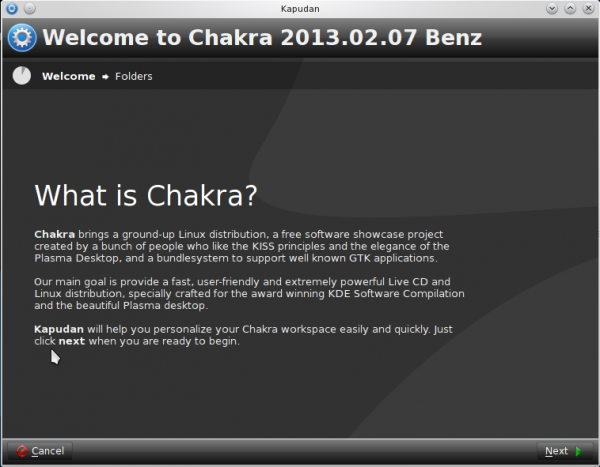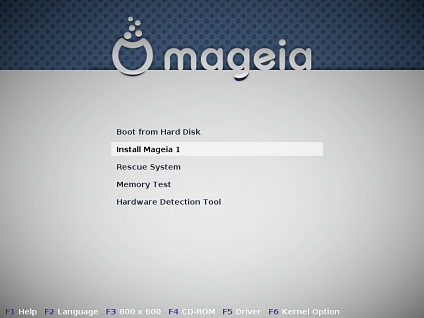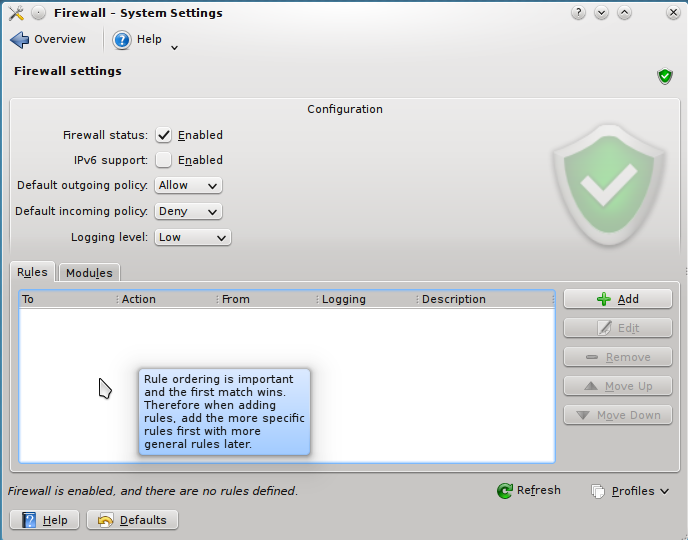Chakra 2013.02 Benz released. No new features implemented in Tribe, the graphical installation program, Kapudan, the first boot program, gets new features.
Chakra is a desktop distribution forked from Arch Linux. Like Arch Linux, it is a rolling-release distribution, which means once you install it in your computer, you never need to reinstall when a new version comes along – the process of applying updates takes care of that.
The latest edition (released Sunday, February 10), is Chakra 2013.02, code-named Benz.
Not too long ago, Chakra Linux was one of my favorite desktop distributions, even made my list of the Top 6 KDE distributions in 2011.
But problems with its graphical package manager, and the fact that latest releases do not even ship with one, has seen it drop off my list, at least for now. The package manager issue and other feature-related issues with the installer are yet to be resolved. (Note: Chakra’s developers are working on a graphical package manager called Akabei.)
This quote from the latest edition’s release announcement sums up all you need to know about what you won’t be getting from Chakra Linux:
The Chakra-Project team is fully aware a distribution is far more judged by what is not accomplished yet, than by what is. Though many of the things we set out to get done 3 years ago are implemented, there still are three major features missing. Most obvious is no GUI for package management. Our own package manager, Akabei, is in Alpha 2, not ready to be used. Tribe’s partition page is missing the Solid integration one of our devs worked on during the last GSoC, to have automated partitioning and support for LVM, RAID, LUKS and the likes, which we know are needed for a complete, modern installer. Plus the option to choose a minimal/netinstall is needed.
Note: Tribe is Chakra’s graphical installation program.
Now that you know what’s missing, the following gives you an idea of what the distribution offers.
Kapudan: Other than Pardus, Chakra Linux is about the only other distribution (that I’m aware of) with a graphical first-boot application that’s actually very useful. Christened Kapudan, it is actually a fork of Pardus’ Kaptan.
So the first time you boot into a fresh installation of Chakra Linux, you are presented with Kapudan’s Welcome page. From there on, it’s a point-and-click configuration of several aspects of desktop.

All those folders you see in a user’s home directory on other Linux distributions are missing from a fresh installation of Chakra, in keeping with the distribution’s philosophy. In previous editions, you had to create those folders from Dolphin or the command-line. With this edition, you are given the option of creating them from Kapudan. Just click on each icon and it’s created for you. Not creating these folders by default has never made sense to me, but at least you can now create them via a point-and-click interface.

The Kickoff menu is the default menu style on most KDE desktops, but in Chakra, Kapudan offers fours menu styles to choose from – Kickoff, Classical, Lancelot and Homerun. The beauty of Kapudan is that it can be run at anytime, so if you choose, say, Homerun at this step and change your mind a few days later, you can just launch Kapudan and choose a different menu. It should be noted that you do not need Kapudan or any other program to switch from Kickoff to the Classical or Simple menu style. If using either, simply right-clicking on the menu icon gives you the option to switch to the other. All four menu styles may also be added to the panel in the traditional way.

Configuring package updates interval is the other thing that can be accomplished from Kapudan.

This step shows where I think the greatest promise of Kapudan lies. You can call this the security step. And it is where you can enable/disable the firewall and get information about other security tools available in the repository. What would be really cool is to be able to enable or disable the other security applications from Kapudan, rather than just links to a Web page that contains information about them.

Once you are done with Kapudan, then you can start using the system. Chakra 2013.02 Benz ships with (Linux) kernel 3.7.6 and KDE 4.10. That’s the latest stable edition of KDE. This screen shot shows what the default desktop looks like. The menu is the Lancelot menu.

And this one shows it sporting the Homerun menu.









Kind of ironic that such a KDE-centric distro offers a graphical installer for non-KDE applications, but not for KDE ones.
Not mentioned in this review which was mentioned in a previous review here are the hoops that must me but jumped through just to print something in Chakra. For some reason a Canon printer will not setup in Chakra, check the forums there and see. What is strange though, is that Slackware, which is supposed to be a problem to setup for so many loads Canon printers from the KDE settings center, without trouble! Why can’t Chakra devs figure that out?
“Never seriously considered a page for keyboard setup as a feature to be trumpeted”
And yes, that’s bcause you never tried to code something like this, but took me a good bunch of hours. I really don’t care, but this is the first string, and is far from be accurated.
cakra is a distribution derived from Arch, but now completely independent!
Manjaro goes fast, because it copies the work of others 😛
and copies bad
Nobody copies. That’s opensource thus you can get te code, change it and use it as you like. However, Manjaro is a distrolet which uses Arch repositories thus the biggest job is already done by others like all the *buntus. Still is a good solution for quickly installing Arch.
No copying, hey it opensorce beauty!This is true, but it is also true that everyone has their own style, and everyone gets an opinion, as I have done my!
Manjaro has its own dedicated and more tested and stable software repositories (among other differences) rather than the official Arch repositories, so it’s more than just an easy way to install Arch. The AUR is accessible, though. See http://wiki.manjaro.org/index.php/Arch_User_Repository
“Chakra 2013.02 Benz released. No new features implemented in Tribe”
Well actually that’s not true. Tribe got a new page for selecting the keyboard setup`with preview which takes the boot settings to stablish the default keyboard, alongside many improvements in many areas like check for minimal memory needed, check for unplugged PA in laptops via Solid alongside with a ton of bugfixing.
Ok, by that, I was actually referring to features, like LVM, disk encryption, and RAID, that were noted in the release announcement. Never seriously considered a page for keyboard setup as a feature to be trumpeted.
A pretty nice distro that shows promise. However I think Manjaro has achieved more in the short time it has been evolving if an Arch based system is what you’re after. Before someone jumps in with comments about Archbang and Crunchbang: yes I am aware of and have tested them but personally do not like Openbox DE. Manjaro also has an openbox derivative but I prefer xfce or kde.
Chakra is not an Arch based distrolette as the ones you mention here. It is a complete independent fork for 3 years now, with very different goals, packaging standards, all packages in every repo build by and for Chakra.
Tribe no changes? The Marble/Globe page was completely redone, with many locations added, user creation page, did not notice all the changes with supporting password strength meter, warnings about what characters are supported and not? Expanded user creation widget, so root and user password settings are always visible?
Then the complete new keyboard page? That does not qualify as a change?
We understand a distro is only judged by what is not accomplished yet, but to state that nothing was done, and repeat as a “review”, just one paragraph of the Chakra announcement……
Did I neglect to mention that Chakra is a fork? No.
First sentence of 2nd paragraph says, “Chakra is a desktop distribution forked from Arch Linux.”
Maybe not clear enough, but the first paragraph was a reply to previous commenter, stating Chakra was just another Arch based project.